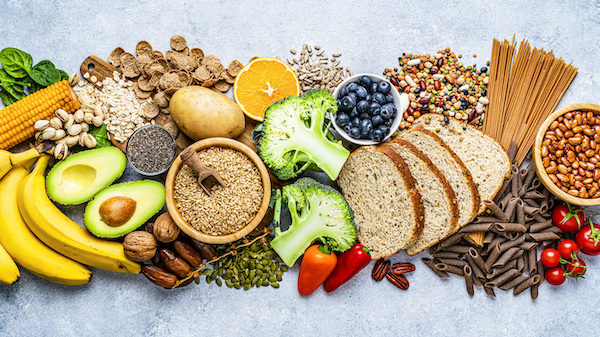Authored by Dr. Sharon Stills, NMD
Insulin resistance — also known as syndrome X — happens when your body can no longer use insulin effectively to manage the amount of sugar you’re taking in from carbohydrates like white bread, pasta and cookies.

Here’s what happens:
- Simple carbs are broken down by your digestive system into sugar, or glucose.
- Your body releases insulin to signal your cells to take in glucose from carbs.
- If you eat too many simple carbs, you take in more sugar than your body needs, which leads to excess amounts of glucose.
- Your body then churns out more and more insulin as it tries to get the glucose out of your blood and into your cells.
- Soon, you produce too much insulin and your cells stop responding to it — now you are insulin resistant.
- You will notice symptoms of insulin resistance such as obesity, high blood pressure and high cholesterol but you may not connect them to the real root of the problem.
If this pattern continues, your insulin resistance will put you on the path to prediabetes, followed by type 2 diabetes and all the other health issues that go along with it.
Insulin resistance in women
Insulin resistance is extremely common though many women are still shocked to learn they already have it, or even prediabetes. Experts estimate that more than 80 million of us already have insulin resistance though we believe the percentage is much higher among perimenopausal women.
Since insulin is one of the “major” hormones, it affects other “minor” hormones and how they behave. When insulin is imbalanced, it’s impossible for your body to balance its minor hormones, including estrogen, progesterone and testosterone, until healthy insulin metabolism is restored.
So if you have hot flashes and other perimenopause symptoms, and you are insulin resistant, you will never be able to effectively relieve those hot flashes until you heal the insulin resistance. This hormonal domino effect will continue generating other symptoms and health issues as times goes on.
But you can change this scenario and reverse insulin resistance and in most cases, you can do it naturally.
Insulin resistance is linked to chronic diseases
Women who are insulin resistant are at much greater risk for a long list of serious health issues such as:
- obesity and belly fat
- diabetes
- hypertension
- heart disease
- high cholesterol
- breast cancer
- polycystic ovarian syndrome (PCOS)
There is also evidence that insulin resistance may contribute to endometrial cancer and it has also been implicated in Alzheimer’s disease.
Insulin resistance is often at the root of the fatigue and weight gain that so many women experience at midlife. As women approach menopause, they can become increasingly intolerant of carbohydrates so it’s easier to gain weight, especially around the waist.

Insulin sensitivity is good
You can understand how the process can go wrong when you know how insulin is supposed to work in your body. When you eat, the food is broken down during digestion into proteins, micronutrients and glucose. The body uses the proteins and nutrients for cellular metabolism, immune function and cell replacement.
Glucose is important too. It’s energy for your body and the only fuel your brain can use. Insulin gets the fuel for energy into the cells without changing the level of blood sugar. And that’s where insulin comes in. Your body and brain need the right amount of glucose in a steady supply to remain stable.
Under these kinds of healthy conditions, your body is “insulin sensitive.” As a hormone, insulin signals the cells to absorb glucose from the bloodstream. Insulin is released in just the right amounts because your body monitors what you’ve digested, your blood sugar levels and the demands your cells are making.
But this balance is tipped if you regularly eat too many simple carbohydrates because your body has to release a lot of insulin to keep the level of glucose steady. Over time, the cells stop “listening” to the insulin messages and the glucose continues to circulate in your blood rather than being taken up by the cells. This directly raises your blood sugar level.
So all that circulating glucose makes your body release even more insulin and the cascade of insulin resistance health effects begins. Your healthy metabolism is disturbed and inflammation becomes a regular event in your body.
When you can’t keep blood glucose under control, you become diabetic and vulnerable to all the other problems that can lead to.
Insulin resistance: top risks for women
The top risks for developing insulin resistance include:
- type 2 diabetes
- having gestational diabetes at some point
- hypertension
- being seriously overweight
- having an apple-shaped body
- an abnormal amount of fat or cholesterol in your blood, especially with low HDL levels and high triglycerides
- developing acanthosis nigricans (wart-like, darkened skin patches on neck and armpits)
If you end up being diagnosed with insulin resistance, you can make changes to reverse it, but you have to take them seriously. Many of these diet and lifestyle shifts are simple in concept, but aren’t necessarily easy. You may not be able to make every change right away, but if you are able to steadily make improvements and stick to them, the payoff is worth it.
How to have healthy insulin levels
Ask your healthcare provider to help you find out where you are on the insulin resistance spectrum. You’ll likely have a blood test that looks at your glucose and insulin levels after you’ve fasted for 12 hours and then again two hours after a high-carbohydrate meal. On the fasting tests, it’s best to see glucose levels of no more than 75–80, and insulin at around 5.
There’s a lot you can do to have healthy insulin sensitivity and to help bring all your hormones back into natural balance.
Have your triglycerides checked.
Increased triglycerides can help confirm a diagnosis of insulin resistance in certain cases. If triglycerides amount to about half of the cholesterol number, it means that your body is metabolizing fat well.
Create a new diet.
Build a balanced, whole-food-based diet out of lean protein, high-fiber grains, vegetables and legumes, leafy greens and fruit. This helps balance insulin levels. Have no more than 15 grams of carbohydrates per meal, and make them mostly vegetables and fruits. Snacks should contain no more than about 7 grams of carbohydrates. Make it a point not to get too hungry to help your blood sugar stay stable. Don’t skip meals or snacks.
Get a little exercise.
Physical activity for about 30 minutes or more per day 3–5 times a week helps regulate metabolic function and supports hormonal balance. It’s very important to make this a permanent commitment, both for healthy blood sugar and overall wellness, especially in menopause and beyond. Encourage yourself to do it and don’t give up. Just keep going.
Take a step toward better health by deciding on the changes you will make today to help maintain good insulin sensitivity. When you wake up tomorrow, have a healthy breakfast and go on a walk or set aside some time that day for exercise. Then do it.
Your body will thank you and be more energetic, and you’ll feel better too.










